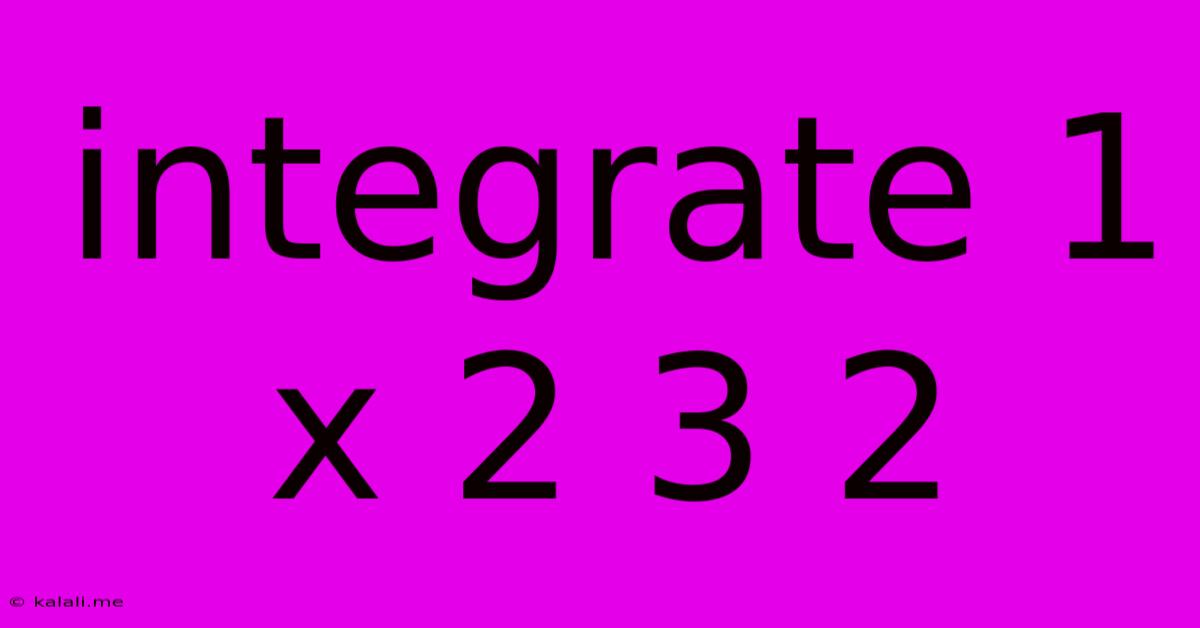Integrate 1 X 2 3 2
Kalali
May 31, 2025 · 3 min read

Table of Contents
Integrating 1 x 2 x 3 x 2: A Deep Dive into Factorials and Beyond
This article explores the seemingly simple calculation of 1 x 2 x 3 x 2, delving into its mathematical context, demonstrating its application in various fields, and highlighting its connection to more complex mathematical concepts. The meta description is: Understand the calculation 1 x 2 x 3 x 2, explore its mathematical underpinnings, and discover its real-world applications in combinatorics, probability, and beyond.
This expression, while straightforward to compute (resulting in 12), provides a springboard to discuss several important mathematical ideas. Let's break down its components and explore their broader significance.
Understanding the Fundamentals: Factorials and Permutations
At its core, the expression 1 x 2 x 3 x 2 resembles a factorial calculation, albeit incomplete. A factorial (denoted by !) is the product of all positive integers less than or equal to a given positive integer. For instance, 3! (3 factorial) is 3 x 2 x 1 = 6. Our expression, 1 x 2 x 3 x 2, can be viewed as a modified factorial, missing the final '1' from the 3! sequence.
This slight modification hints at the concept of permutations. A permutation is an arrangement of objects in a specific order. In our case, we could interpret the expression as the number of ways to arrange three distinct objects, where one of the objects appears twice. Imagine arranging three balls: one red (R), one blue (B), and one green (G). The number of ways to arrange these is 3! = 6. Now, if we have two identical green balls, the number of arrangements reduces, represented by our calculation of 1 x 2 x 3 x 2 = 12. This reflects the fact that some arrangements become indistinguishable due to the identical green balls.
Applications in Real-World Scenarios
The concept of permutations, directly related to our calculation, finds applications in various fields:
- Combinatorics: Determining the number of ways to arrange items, select subsets, or assign tasks is crucial in combinatorics, a branch of mathematics concerned with counting. Our example perfectly illustrates the problem of arranging objects with repetitions.
- Probability: Calculating probabilities often involves determining the total number of possible outcomes. Permutations play a significant role in calculating probabilities in scenarios involving arrangements or ordering of elements.
- Computer Science: Algorithm design and analysis often involve understanding the number of possible arrangements or permutations of data structures. This impacts efficiency and optimization of algorithms.
- Cryptography: The study of permutations is fundamental in cryptography, especially in the development of secure encryption and decryption techniques.
Expanding the Concept: Beyond Simple Calculations
While 1 x 2 x 3 x 2 provides a simple example, the underlying principles extend to more complex calculations involving larger numbers and more repetitions. The same logic can be applied to expressions like 1 x 2 x 3 x 4 x 4 x 5, requiring a more nuanced approach to count permutations with multiple repetitions. Advanced combinatorial techniques are needed to tackle such scenarios effectively.
Conclusion
The seemingly simple expression 1 x 2 x 3 x 2 opens a door to a deeper understanding of factorials, permutations, and their applications across diverse fields. It serves as an excellent introductory example to explore the fascinating world of combinatorics and probability. This understanding is invaluable in many areas, from theoretical mathematics to practical applications in computer science and beyond.
Latest Posts
Latest Posts
-
Fyne Packages App Can Not Use Sqlite3 Mac
Jun 02, 2025
-
How To Build Garage Shelves From 2x4s
Jun 02, 2025
-
How Do I Find Alice In Kingdom Hearts
Jun 02, 2025
-
Why Is Matrix Multiplication Not Commutative
Jun 02, 2025
-
Toilet Runs Every Once In A While
Jun 02, 2025
Related Post
Thank you for visiting our website which covers about Integrate 1 X 2 3 2 . We hope the information provided has been useful to you. Feel free to contact us if you have any questions or need further assistance. See you next time and don't miss to bookmark.